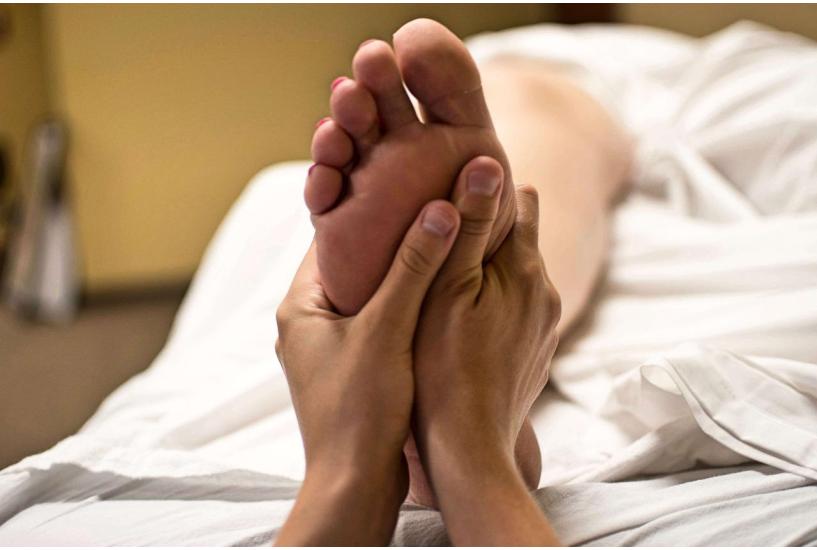Supporting Lymph Health
by Christopher Vasey, N.D., author of Lymph Health and many other books
The lymphatic system has been misunderstood for some time. Its existence was not really discovered until the seventeenth century.
The reason it has been ignored stems from the fact that, unlike the circulatory system, the lymph system does not have a great deal of visibility. Blood is bright red, making it easy to see and to detect the vessels through which it circulates. In addition, the beating of the heart and throbbing of the arteries can be clearly felt.
There is nothing like this for lymph, however. Because it is a clear, transparent fluid, lymph gives the lymphatic vessels and capillaries a whitish color that makes them difficult to see. Its progress through the vessels is so slow that it causes no surface fluctuations that would suggest its presence. The lymphatic system doesn’t have an organ like the heart to pump the lymph, so it has no heartbeats or vessel impulses to invite scrutiny.
Modern studies of the lymphatic system have made it possible to know it better—much better. The further the research goes, the more evident is the fundamental role it plays in body function, and its effect on overall health.
Despite its lack of notoriety, the lymphatic system is not only an essential player in the general circulation of fluids throughout the body, but also one of the primary components of the immune system. Furthermore, it plays a decisive role in the detoxification of the physical organism.
The multiple functions of lymph make it a key element for understanding the cellular terrain, or environment, and this is why it is of such interest to natural medicine modalities. In fact, one of the fundamental notions on which natural medicine is based is that the deep roots of disease reside in the cellular terrain. Dr. Paul Carton (1875–1947), a French pioneer of natural medicine, emphasized this when he said: “The state of the terrain takes precedence over everything.” The appearance and development of acute and chronic diseases depend on the state of the terrain, which is the fluid environment of the cells. Depending on its composition, the body stays healthy or falls ill. And this composition is highly dependent on lymph.
In my book Lymph Health explore the three major functions of the lymphatic system: circulation, immunity, and detoxification. I show what weakens the lymphatic system and what diseases this can cause.
In the practical part of the book I look at different therapies that can be used to strengthen and restore proper lymph function. These therapies are quite varied and rely on physical exercise, diet, and medicinal plants, as well as massage and/or toxin drainage. The therapies are presented in a way that lends itself to application for readers who want to use them either alone or in collaboration with a therapist. In this way the patient can take an active part in treatment and self-healing.
Lymph Health, however, is not only for people suffering from lymphatic disorders but also for those who wish to avoid them. It is a very useful guide to prevention.
In addition to extensively exploring foundational therapies for lymph health (changing your diet, detoxification, physical exercise, and hydration) in the book, I also look at complementary therapies that stimulate the lymphatic system in specific ways. These therapies do not address the causes for a weakened lymphatic system (like the foundational therapies do), however, they are very helpful when used in combination with foundational therapies.
Let’s take a look at one of the complementary therapies: Foot reflexology.
Foot Reflexology for Lymph Health
Foot reflexology, like all lymphatic draining methods, is a therapeutic approach that makes it possible to work directly on the lymphatic system. It can also reach lymphatic organs in the depths of the body, such as the Pecquet cistern, tonsils, and spleen.
Reflex zone massage is something everyone can perform and the technique is easy to learn and self-administer. It is also possible to turn to one of the many therapists who practice this treatment.
Foot reflexology acts at a distance on the organs via the intermediary of the nerves, by massaging the reflex zones that are located primarily on the soles of the feet. There are, however, a few points on the top side of the feet and on the ankles; this is the case for the reflex zones connected to the lymphatic system.
The massage of a reflex zone not only receives but also sends information to the organ connected to it. This is indeed a reflex action as the organ reacts automatically to the stimulation transmitted by the nerve. The effect of this stimulation is to activate the blood circulation of the organ involved, stimulating elimination of the toxins that are congesting it and preventing the organ from functioning properly. Reflex massage therefore intensifies the work of the lymphatic organs whose reflex zones are massaged. This improves not only lymph circulation but the defensive and detoxifying capacities of the lymphatic system as well.
Massage of the foot reflex zones is done with the help of the thumb or phalanx joint of a finger, generally the index finger. The reflex zone selected is then rubbed in a circular motion with varying pressure. Smearing the zone with lotion beforehand will make the massage easier.
In the beginning the treatment should last only a few minutes (two to five). It should be performed on both feet given the fact that most organs have two reflex zones, one on each foot.
The location of the lymphatic system reflex zones is shown in the illustrations that follow, along with small anatomical explanations. Your sense of touch will allow you to complete this information and find exactly where the reflex zone is located. The zones that need to be massaged are generally painful when pressure is applied to them.
The pain is caused by toxins that have collected in the reflex zones and can make the zone hurt even when it is not being massaged. This indicates that toxins have accumulated in not only the ailing organ but in its reflex zones as well.
In the beginning, massage of the reflex zones will be performed gently so as not to cause the patient too much pain or release too many toxins at one time. When a lot of toxins enter the blood at the same time, the body can be temporarily overwhelmed and manifest a variety of disorders, such as headache, nausea, irritability, insomnia, or fever. These disorders are not very serious but they are unpleasant, so it is better to avoid them. Therefore this circular rubbing massage technique should be applied more strongly only gradually, so as to increase the strength of the massage without reaching the discomfort zone.
The duration of reflex zone massage increases over time. From two to three minutes per zone in the beginning to ten minutes, then to twenty or thirty minutes. One massage session a day is the normal rhythm, but two or three shorter sessions a day have also proven beneficial. The stimulating effect of a session, which necessarily fades over time, is thereby relaunched the same day with more sessions.
The first effects on the lymphatic system can appear quite quickly, after a week or two. Several months are needed, though, to get profound results.
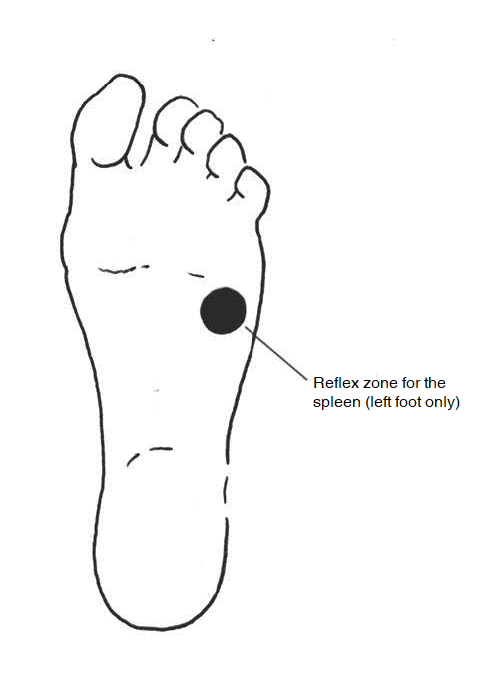 |
Reflex zone of the spleen. This stimulates this organ’s functioning. The zone is located on the bottom of only the left foot. |
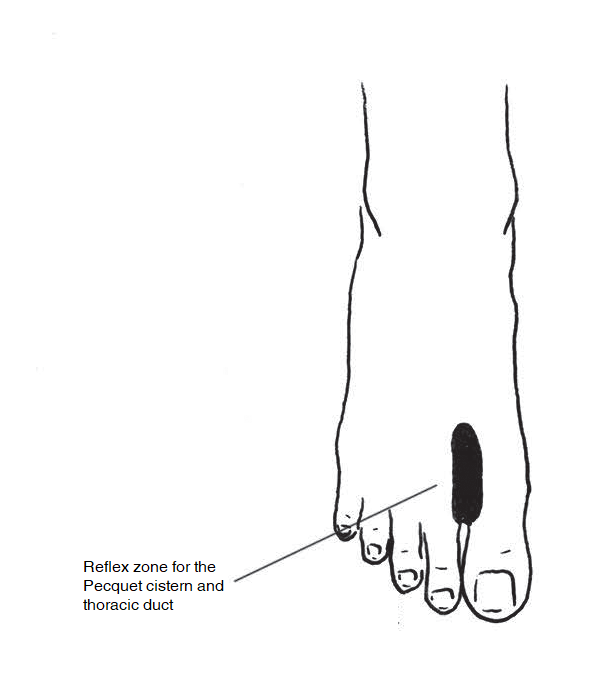 |
Reflex zone of the Pecquet cistern and the thoracic duct. This stimulates the circulation of lymph in these two organs and thereby in the rest of the body. It is located on both feet, in the hollow spot between the first and second metatarsal bones. |
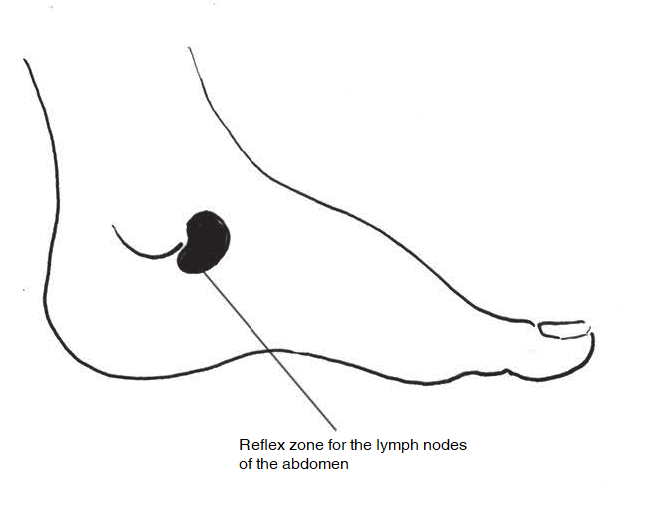 |
Reflex zone of the abdominal lymph nodes. This area drains the legs, abdomen, and pelvis. It is located on the top of both feet in a small hollow just before the inside of the ankle bone. |
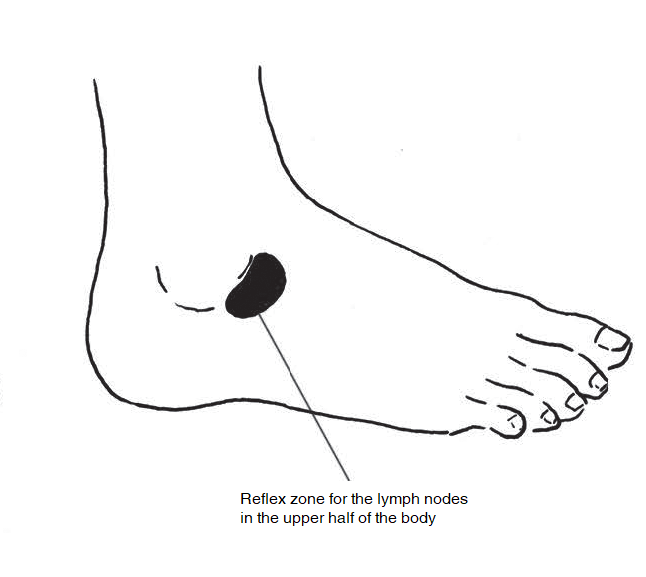 |
Reflex zone of the thorax lymph nodes. This area drains the upper half or the abdomen and the head. It is on top of both feet in the small hollow just before the outside of the anklebone. |
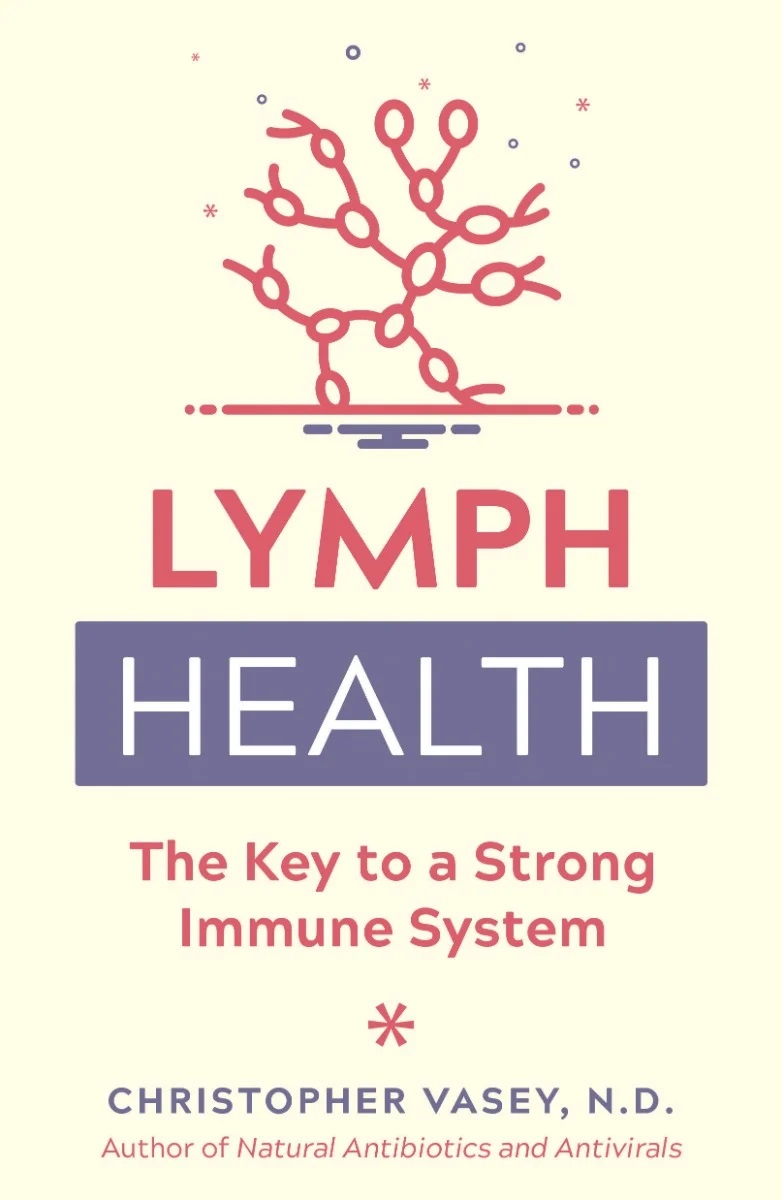 |
 |
 |
 |
 |


